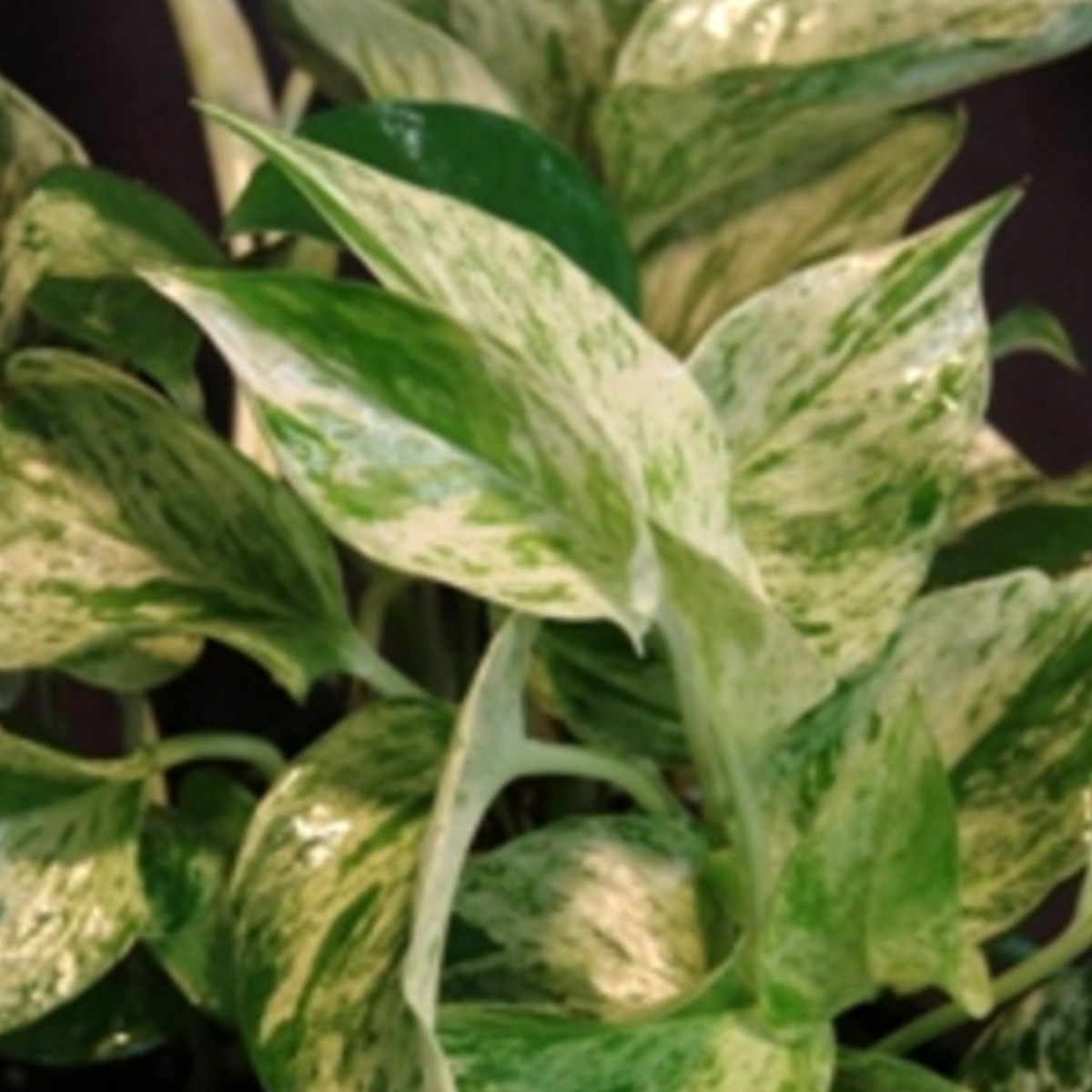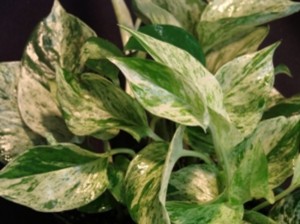Family: Araceae
Synonyms: Epipremnum aureum
Pothos aureus
Distribution & Habitat:Native range extends from Northern Australia through Malesia and Indochina into China, Japan and India. The species have become naturalised in tropical and sub-tropical forests worldwide, where it has caused severe ecological damage in some cases.Scindapsus aureus can become a highly invasive species when introduced into tropical countries where it is not native. Having no natural enemies, it completely overgrows the forest floor as well as the trunks of trees, causing severe ecological disruption.
In temperate regions Scindapsus aureus is a popular houseplant with numerous cultivars selected for leaves with white, yellow, or light green variegation. It is often used in decorative displays in shopping centers, offices and other public locations largely because it requires little care and is also attractively leafy.Scindapsus aureus is also efficient at removing indoor pollutants such as formaldehyde, xylene, and benzene. As a houseplant it can reach a height of 2m (80 inch) or more when given suitable support.
Description: Scindapsus aureus 'Marble Queen' has large, glossy, heart-shaped leaves of green marbled with cream, are a feature if this indoor plant. Train up a totem pole or grow in a hanging basket or decorative pot to best display its attractive foliage. The leathery, shiny-surface, hart-shaped leaves are arranged alternately on 5-8cm (2-3 inch) long leaf-stalks. Flowers are not produced indoors. Scindapsus aureus 'Marble Queen' is closely related to heart-leaf philodendron, which it resembles.
Scindapsus aureus 'Marble Queen' can be trained to grow upright on stales, wires or strings. they also can be encouraged to use their aerial roots to support themselves on stabs of rough tree bark as long as the bark is kept constantly moist. Or they can trail down from either, pots or hanging baskets.
Proper Care: Scindapsus aureus 'Marble Queen' is a very easy plant to grow and as long as certain instructions are followed, this pretty plant will grow quickly and provide the rooms with a colourful leaf display. Best grown in warm spot protected from droughts. Keep moist but not wet and apply liquid fertilizer during the growing season for lush new growth.
In order to prevent the Scindapsus aureus 'Marble Queen' from growing too big, cut back the stem of larger plants every spring to a point just in front of a healthy leaf.
Water: Water it regularly but less so in cold weather. The leaves need frequently mist. Leaf drop is a good indication of over watering. Scindapsus cannot survive in waterlogged soil.
During the active growth period water moderately, allowing the top cm (0.5 inch) or so of the potting mixture to dry out before watering again. During the winter rest period give just enough to prevent the potting mixture from drying out completely.
Light:Scindapsus aureus 'Marble Queen' prefers indirect or curtain-filtered sunlight. Bright filtered light throughout the year is best for those plants. At low light levels the leaves lose much of their colour contrast.
Temperature: Normal room temperatures are suitable during the active growth period. Give toScindapsus aureus 'Marble Queen' a winter rest around 15C (59F), if possible. Scindapsus aureus 'Marble Queen' is extremely sensitive to a sudden drop in temperature below 10C (50F).
For increased humidity in warm rooms it is a good idea to stand pots on trays of damp pebbles, and suspended saucers of water under hanging baskets.
Feeding: Apply standard liquid fertiliser about once every two weeks during the active growth period. To fertilize new plant wait six months.
Potting and repotting: Use a soil based potting mixture. Move plats into pots one size larger every spring until maximum convenient size (probably 20cm (8 inch)) has been reached. Thereafter, top dress every spring. If plating in a hanging, place five or six rooted cuttings around the rim of the basket. These will have enough space for only two or three years. After that replace them with newly rooted cuttings in fresh mixture.
Uses: Scindapsus aureus 'Marble Queen' as a tropical vine with variegated foliage and vigorous growth is used as indoor planters or greenhouse plant. Scindapsus aureus 'Marble Queen' is ideal plant for offices, shopping centers, hotels and other public areas because easy maintenance and relative reduced light requirements and because they are efficient at removing indoor pollutants. This plant is ideal equally as homeplant in a hanging basket, climbing a plant pole, or spilling over the edge of a table or shelf.
NASA places this plant among the top 3 types of houseplants great for removing formaldhyde. Also known for removing carbon monoxide and increasing general indoor air quality.
Propagation: Propagate it from stem cuttings, from sections of main stems or by air layering.
Scindapsus aureus 'Marble Queen' can be propagated in spring from tip cuttings 8-7cm (2.5-3 inch) long. Take each cutting immediately below a node, remove the bottom leaf and dip the cut end in hormone rooting powder. Plant three or four cuttings together around the rim of an 8cm (3 inch) pot (or several into a hanging basket) of soil-based mixture and treat them as mature specimens.
Toxicity: The plant is toxic tohouse pets such as cats and dogs, because of the presence of insoluble raphides. Care should be taken to ensure the plant is not consumed byhouse pets or children. Symptoms may include oral irritation, vomiting, and difficulty swallowing.
Some people develop a skin rash as a result of contact with the plant sap. Wear gloves when pruningScindapsus aureus 'Marble Queen' ivies to prevent this kind of reaction.
Problems:
Yellowing and Falling Leaves: The cause is overwatering especially in winter. Scindapsus aureus 'Marble Queen' cannot survive in waterlogged soil.
Brown and Shrivelled Leaf Tips: The air is too dry, mist the leaves regularly.
Brown Leaf Edges; Brown Spots On Leaf Surface: The cause is underwater during the growing season. The surface of compost should become dry between waterings but root ball must not be allowed to dry out.
Curled Limp Leaves: The cause is cold air damage. Scindapsus aureus 'Marble Queen' is extremely sensitive to a sudden drop in temperature below 10C (50F).
Pest: There are a few problems you may encounter with this plant. Mealybugs are one of the most common insect problems that will have the Scindapsus aureus 'Marble Queen'. Treat the plant a week or two with a spray mixture of water and rubbing alcohol, followed with a wash down with mild liquid dish soap and water. Treat until run off, let dry then apply the second wash. Apply this treatment twice a week for two weeks and the plant should be safe. Never apply this treatment with the plant in the sun or when the soil is dry.
Scindapsus aureus 'Marble Queen'characteristics:
- Can be trained to climb on a totem pole
- Scindapsus aureus 'Marble Queen'is suitable for hanging basket as well
- Indoor filtered light
- Liquid Fertilizer
- Low maintenance
- Plant type: Climber
- Foliage: Evergreen
- Foliage colour: Green marbled with cream
- Flower: Insignificant
- Suitability Climate zones: Humid subtropical, humid tropical
- Light requirements: Shade, semi-shade
- Soil type: Loam
- Minimal temperature: 14-16C (57-60F)
- Optimal Temperature: 22-26C (71-78F)
- Size: 1-2 m (40-80 inch)
- Hardiness zone: 10a-11



